
In today’s fast-paced environment, chronic fatigue is often mistaken for normal tiredness. The constant pressure to excel and juggle endless responsibilities can hide the real issue: burnout. This article explores the subtle, creeping nature of burnout, unveils its hidden signals, and offers actionable steps to regain balance and well-being. By examining practical examples, the latest scientific research, and self-care advice, we help you understand when persistent fatigue is more than just an occasional slump. Recognizing the difference between everyday tiredness and clinical burnout can be the breakthrough toward a healthier, more fulfilling life.
Understanding Burnout in the Modern World
Burnout is more than just the tiredness at the end of a long day—it is a comprehensive state of physical, emotional, and mental exhaustion caused by prolonged stress and unmet expectations. In our modern society, burnout can affect anyone, even when success seems close at hand, leaving many confused about what constitutes normal fatigue.
Recent psychological studies reveal that routine exhaustion may slowly escalate into a full-blown crisis if not addressed. The endless stream of responsibilities, unrealistic goals, and a culture that prizes overachievement over well-being all fuel this condition. Learning to identify these dynamics is critical to preventing further damage.
In 2023, experts noted that burnout is not limited to certain professions or age groups—it affects everyone facing relentless pressure without sufficient time to recover. This realization has spurred extensive research aimed at distinguishing occasional tiredness from a harmful, chronic condition.
Recognizing the Hidden Signs of Routine Exhaustion
The subtle signs of burnout can easily go unnoticed, often being confused with ordinary stress or mere laziness. Symptoms such as chronic headaches, irritability, and a loss of interest in activities you once enjoyed can indicate deeper issues. Spotting these signals early is key to preventing more serious problems down the line.
Often, routine exhaustion disguises itself as everyday weariness. You or someone close might seem fine on the surface while secretly battling overwhelming internal emptiness. Over time, what starts as manageable stress can build into a serious mental health crisis. Despite numerous studies and surveys, many still dismiss these early warning signs as trivial rather than urgent red alerts.

In our increasingly connected world, the blend of work and personal time makes it even harder to spot burnout. Constant digital connectivity and the pressure to be always available contribute to feelings of inadequacy. Recognizing and validating these lingering symptoms is essential to breaking the cycle of burnout.
Emotional Detachment
Many people experiencing burnout report a feeling of emotional numbness or detachment from their surroundings—a defense mechanism against overwhelming stress. Identifying this disconnection early on is vital for the recovery process.
This emotional distancing can impact personal relationships and work performance, creating a self-reinforcing cycle of isolation. What may appear as indifference is often the mind’s plea for help.
Physical Ailments and Cognitive Overload
Burnout can also show up through unexplained physical symptoms like constant aches, frequent infections, or sleep issues. These are clear indicators from your body that it is under strain.
In addition, cognitive overload—difficulty in decision-making and muddled thinking—can seriously affect everyday life. Understanding these physical and mental signals is crucial to taking timely preventive measures.
Practical Strategies to Combat Burnout
While burnout can seem overwhelming, practical and proven strategies can help you regain control over your stress. Simple habits like taking short breaks, practicing mindfulness, and reworking your daily schedule are effective ways to counteract chronic stress.
Therapeutic options such as cognitive behavioral therapy and regular mindfulness exercises are gaining stronger support through recent research. Furthermore, integrating practical self-care routines and achieving a balance between work and leisure can alleviate current stress and protect against future burnout.

Setting realistic goals and incorporating self-care into your daily routine can break the cycle of constant stress. Consider minor adjustments—like scheduling regular downtime or engaging in physical activity—that together form a strong foundation for both mental and physical health.
Mindfulness and Meditation
Mindfulness techniques have proven benefits, including reduced stress, improved concentration, and overall enhanced well-being. Even a brief daily meditation session can yield significant benefits.
Practices such as mindful breathing or guided meditation can help recalibrate your stress response, making it easier to remain present and gradually reduce feelings of anxiety and fatigue.
Establishing Boundaries
Learning to establish clear boundaries between work and personal life is fundamental in managing burnout. This often means saying no to extra commitments and recognizing your own limitations.
By allocating distinct times for work and for relaxation, you create a safe space essential for recovery and sustained well-being.
Cultivating Long-Term Resilience and Self-Care
Building long-term resilience goes beyond handling daily stress; it requires a holistic approach that nurtures your body, mind, and spirit. A balanced routine that includes physical activity, nutritious eating, and restorative sleep lays the groundwork for effective self-care.
Resilience isn’t a fixed trait; it’s a skill you can develop over time. Creating a personalized self-care plan that addresses your specific needs is the first step toward lasting recovery.
Connecting with supportive communities and engaging in group activities can also strengthen your sense of belonging. In today’s complex world, these social networks are essential to maintaining long-term mental and physical health and preventing burnout.

Developing a Personal Self-Care Plan
Creating your own self-care plan starts by identifying activities and habits that replenish your energy. This could include exercise, meditation, hobbies, or spending quality time with loved ones.
Regularly reassessing and updating this plan ensures it continues to meet your evolving needs. A dynamic self-care plan is key to effectively combating the challenges of modern life.
Leveraging Professional and Community Support
The support of professionals such as psychologists and counselors is invaluable when dealing with burnout. Their tailored guidance can offer strategies specific to your situation.
In addition, joining community support groups or online forums allows you to share experiences and gain practical advice from others facing similar challenges.
Additional Insights
Beyond the core aspects of understanding and addressing burnout, there are many emerging insights that deepen our knowledge of this complex issue. Recent advances in psychology have explored burnout’s links with workplace culture, digital overload, and societal pressures.
Digital burnout is an increasingly recognized challenge. With technology blurring the boundaries between work and personal life, the constant influx of emails, notifications, and virtual meetings can drain your mental energy. Identifying digital burnout as part of routine exhaustion is crucial in developing a comprehensive self-care approach.
Research shows that workplaces with supportive policies, regular breaks, and open conversations about mental health see lower instances of burnout and higher overall job satisfaction. This evidence underscores the need for a collaborative effort between individuals and organizations to tackle burnout.
Other effective techniques include maintaining a consistent sleep schedule, exploring creative hobbies, and establishing flexible routines that balance productivity with necessary rest. Cognitive psychology confirms that mixing creativity and leisure with work can stimulate brain function and protect against chronic stress. A holistic approach to self-care can dramatically enhance your quality of life.
Engaging in Creative Outlets
Creative pursuits like painting, writing, or playing an instrument can serve as powerful outlets that reduce stress. These activities allow your mind to shift focus and refresh, offering a respite from daily pressures. They remind us that creativity can be the ultimate remedy against routine exhaustion.
Not only do these outlets improve mood, but they also boost cognitive function, creating a positive feedback loop that helps safeguard mental resilience.

Embracing Flexibility in Daily Routines
Rigid routines can often add to the stress. Allowing flexibility in your daily schedule can help you better manage unexpected challenges and adjust to your energy levels.
Experimenting with alternating periods of focused work and short breaks might significantly improve productivity while reducing overall stress levels.
Identifying and addressing burnout requires self-awareness and proactive changes. As discussed, the hidden signs of burnout may be subtle, yet they can impact all areas of life. By adopting effective self-care habits, engaging in open conversations about mental health, and seeking both professional and communal support, you can revive your energy and enthusiasm. Remember, burnout is not a personal shortcoming but a signal from your body and mind that change is needed. Empower yourself by taking that first step toward lasting balance and well-being.




